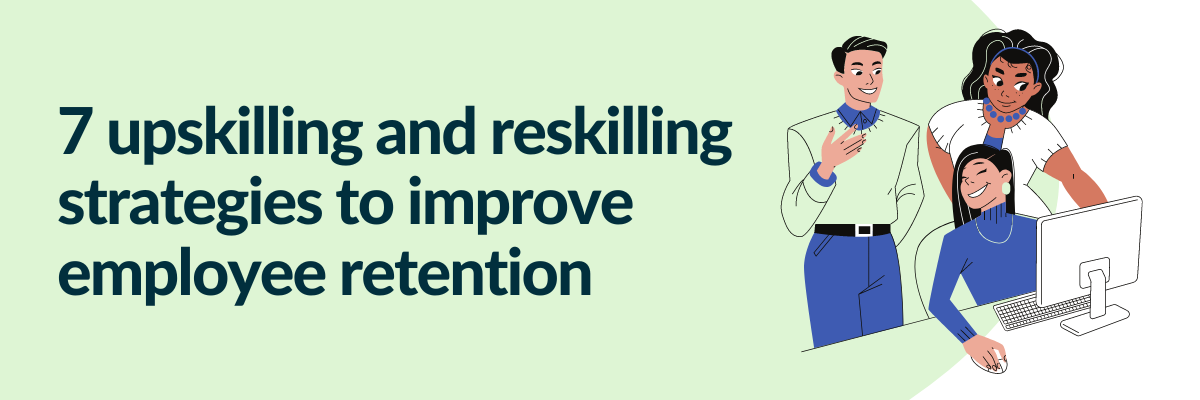7 upskilling and reskilling strategies to improve employee retention
The employee-employer dynamic has seen more than a few shifts throughout history. It has been influenced by power, markets, policies, the economy, and so many other factors.
Today in 2022 within the corporate world, it is safe to say that this relationship is based primarily on value creation. Employees and employers mutually expect a commitment to each other’s growth and if/when these are not met, there are abundant opportunities for either of them to find a better fit.
As employers, when we specifically talk about value creation for employees, setting up systems to enable upskilling and reskilling journeys is one of the most important ways to show them that you are invested in their growth and in turn, pave the way for a long-term partnership. And, that is just the beginning of the many benefits of upskilling and reskilling. Let us take a detailed look at what upskilling and reskilling mean and how they become advantageous to both employees and employers.
Difference between upskilling and reskilling
Primarily, upskilling is connected more to the current roles of employees and looks at adding to their efficiencies through relevant training. As a result, employees become better at their current roles or prepare for advanced roles along the trajectory they are on.
On the other hand, reskilling refers to training employees for completely new roles based on their interests or transferable capabilities while also trying to capitalize on their existing skills as much as possible. This could enable them to set off on a tangential career trajectory.
For example, to a social media executive, upskilling would be to learn to implement and understand social media analytics tools while reskilling would look something like learning UX design. Another example would be a software developer upskilling by learning an advanced programming language versus reskilling by learning project management.
Benefits of upskilling and reskilling
A culture of learning fosters ambition, boosts productivity, gives space for satisfaction as employees see a path to where they ultimately want to be, and eventually creates a robust, motivated workforce that is equipped with the most advanced skillsets.
Upskilling helps employees to:
- Learn the best ways to function in their roles
- Stay up-to-date with the latest technology/best practices which in turn boosts productivity and progress
- Pave the way for a smoother transition into their respective senior roles
- Foster a long-term professional relationship with the employer
Meanwhile, some of the key benefits of reskilling are:
- It empowers employees to tailor their own career paths regardless of traditional trajectories
- It helps employers closely work with employees on career-pathing
- It offers a way to retain highly efficient resources in case their functions become redundant/obsolete to employers
You will notice that the benefits of both upskilling and reskilling are unique but still intersect well for employers as well as employees. It creates a system where the growth of employees fuels the growth of the employer and vice versa.
It naturally comes as no surprise that 93% of CEOs said they saw an increased retention rate and better talent acquisition among many other positive developments when they invested in learning programs for employees. Further, upskilling and reskilling are featured among the top priority in leadership and development(L&D) programs. Interestingly, 79% of L&D professionals also expected to spend more time on online learning, but more on that in just a bit.
Upskilling and reskilling strategies
Now, there is no one right way for employers to create learning avenues. A lot depends on the end goal and preferences of employees. Some of the primary upskilling and reskilling strategies include:
Creating tailored learning journeys
The entire process of upskilling and reskilling heavily involves putting employees first and connecting their personal growth with that of the organization. Essentially, every employee is unique with their own inclinations and capabilities. So, crafting a learning experience tailored to their interests is bound to be much more effective than a generalized approach.
For example, for a marketing head with a tech inclination, a great upskilling direction could be to learn CRM tools to work more closely with customer relationships and understand the sales perspective as well.
Providing opportunities for tailored learning journeys may often involve business travels. In this respect, implementing business travel management will enable companies to strategically plan and allocate resources for their employees' travel needs as well as to streamline logistical processes and enhance their safety and satisfaction.
Using data to create the learning journey
There is a lot more to upskilling and reskilling programs than broadcasting knowledge. Companies that invest in offering data-driven choices and guidance to employees become partners in the employees’ journeys versus being just a certificate course. Also, this sets a culture of data-driven decision-making that is very likely to positively impact the ROI.
Examples of data-driven learning journeys include working closely with teams to understand adjacent skills they are likely to learn easily, identifying learning personas based on historical data, etc. Simplistically, this could look something like offering a course in digital marketing to a copywriter based on data from what a large number of copywriters have chosen before in the company.
Conducting employees survey
Effective learning is always a two-way process. Employee surveys are essential to track progress, understand the data, foster transparency and accountability, and eventually optimize learning journeys. The surveys also help in documenting the evolution of learning programs and contribute to case studies in the long term.
These surveys could be taken through personal interviews, a small questionnaire at the end of each learning module, or through a Google form as well.
Incentivizing learning
The things that companies incentivize and encourage are what grow and become part of the work culture. Incentivizing learning makes it easier for employees to commit to learning and motivates them to keep going further in their journeys. This also creates an environment for more employees to be part of upskilling and reskilling programs which in turn helps companies foster an improved workforce that is more aligned with the organization’s fast-expanding goals.
Incentives could range from monetary ones, credits towards appraisals to even simpler, fun things like a coupon code for their favorite shopping site.
Promoting job shadowing
A culture of learning starts with accessibility. Enabling job-shadowing, where an employee can observe another employee in order to understand their role, function, and day-to-day tasks is a great way to encourage employees to explore what direction they want their learning journeys to take. It gives them a feel of the required skills for a particular role and would help them analyze how it could drive their own growth before committing to the learning.
Shadowing could look something like a marketing manager sitting in on sales meetings to understand how a sales manager communicates with clients and what their role entails. This could give the marketing manager a chance to understand how they can collaborate better with the sales team as well as explore if they are interested in cross-functional training.
Mobile-first learning
Flexible learning options add a lot of value to keeping the upskilling or reskilling journeys of employees sustainable in the long run. And, with the current rate of digitization of work and processes, it is not just an added advantage but is almost imperative that learning programs are mobile-first to seamlessly fit into the routines of employees. It gives them more control over the pace and quality of learning. It also gives the added advantage of accessing learning content across a wider range of platforms.
Aspects like hosting material on the cloud, including more video material, segmenting material into compact modules, etc could be some ways of making learning mobile-friendly.
Measuring and evaluating learning outcomes
Ensuring that there are processes in place to track the journeys of employees, evaluate milestones, track specific learning modules and record progress is very important. This helps organizations understand key metrics like ROI and optimize programs for the company as well as for employees.
Quizzes, assignments, projects involving practical implementations of learnings, etc could be some ways of measuring outcomes.
Throughout our discussion, we explored a lot of ideas around online learning, mobile-first learning, putting employee convenience first on their learning journeys, learning content accessibility, and so on. A lot of this points towards video learning experiences.
Making learning videos part of employee learning journeys is great for both the stakeholders for multiple reasons.
For employees, it is engaging, and accessible across platforms/devices and when compared to text it is easier to retain in mind.
For employers, it segments the learning content much better to allow employees to learn at their own pace, it helps to convey a lot more information in a specific time when compared to text, and tools like Vmaker and Steve AI bring down learning content creation cost and time to a fraction of conventional content creation.
Explore making training videos, instructional videos and so much more with Vmaker’s all-in-one video suite. From screen recordings to webcam recordings in 4k to video editing, creating a learning experience for your employees has never been simpler.
Also, you can use Steve AI to repurpose educational blogs or text material into engaging, high-quality animation/live videos or write just the script and let the AI whip up fantastic videos in just a few clicks. With amazing tools like these, creating great educational content is not time-consuming or resource-intensive anymore and this further boosts the outcomes of learning programs like never before.
So, what are you waiting for? Start today and begin a journey of mutual value-creation and the pursuit of sustained growth with your team.
Here’s to an invincible workforce!



